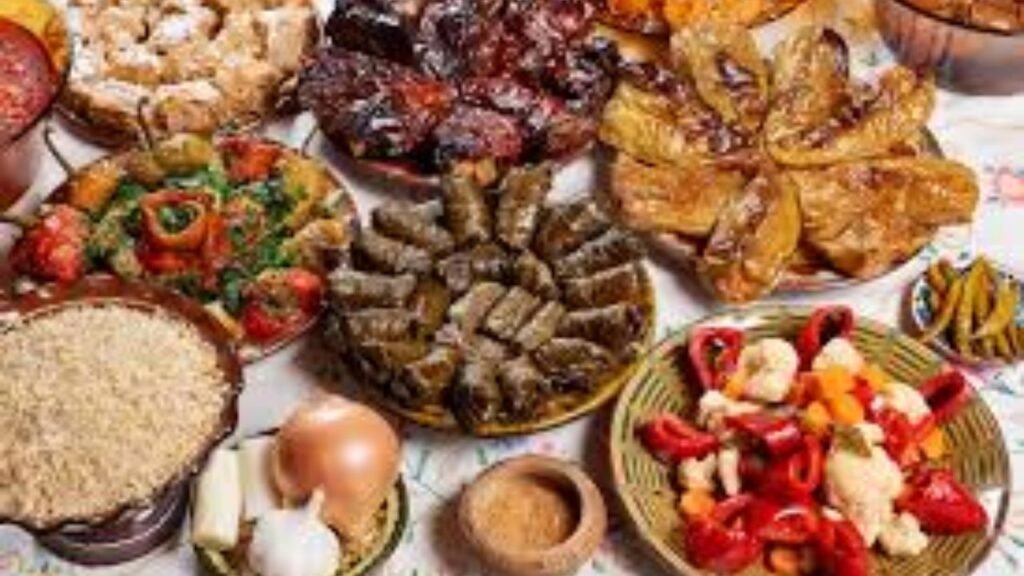Bulgaria may be a small country, but its culinary traditions are big in flavor and history. Bulgarian food combines fresh vegetables, dairy, grilled meats, and herbs to create meals that are both hearty and healthy. Rooted in centuries of tradition, these dishes reflect the nation’s agricultural lifestyle, diverse geography, and cultural influences from the Balkans, Greece, and Turkey.
If you are planning a trip to Bulgaria or simply looking to expand your food knowledge, exploring Bulgarian cuisine is a delicious journey. From comforting soups to sizzling meat platters, Bulgarian food is all about warmth, simplicity, and community. In this guide, we’ll cover the best Bulgarian food to try, along with insights into its food culture and authentic traditions.
Traditional Bulgarian Food

Traditional Bulgarian food focuses on locally grown produce, yogurt, cheese, and slow-cooked dishes that have been passed down for generations. A typical Bulgarian table is never without fresh bread, seasonal vegetables, and hearty stews.
One of the staples is banitsa, a pastry made with filo dough and a mixture of eggs and white cheese. It is a must-try breakfast item and often enjoyed with ayran, a yogurt-based drink.
Shopska salad is another iconic dish, made with tomatoes, cucumbers, onions, peppers, and a generous topping of sirene cheese. Its colors match the Bulgarian flag, making it more than just food—it’s a symbol of national pride.
Soups like tarator (a cold yogurt and cucumber soup) and shkembe chorba (tripe soup) are also central to traditional meals. These soups reflect the balance in Bulgarian cuisine between refreshing summer dishes and hearty winter warmers.
Popular Bulgarian Food

Some Bulgarian dishes have gained popularity not just locally but also internationally. Kebapche, a grilled minced meat roll seasoned with spices, is one of the most beloved street foods. It is often paired with fries and lutenitsa, a pepper and tomato relish.
Another popular food is kavarma, a slow-cooked dish of meat and vegetables baked in clay pots. The use of clay pots gives the dish a rich, earthy flavor.
For cheese lovers, sirene and kashkaval are essential. Sirene is a salty white cheese, while kashkaval is a yellow semi-hard cheese. They are used in salads, pastries, or served simply with bread and wine.
Sach Bulgarian Food

Sach is one of the most iconic and mouthwatering Bulgarian foods. It is a dish cooked on a hot clay plate, where meat and vegetables sizzle together without much oil. The clay keeps the heat steady, ensuring that the ingredients are juicy and flavorful.
Common ingredients include pork, chicken, mushrooms, onions, peppers, and potatoes. The beauty of sach is its simplicity—it allows the natural flavors of the ingredients to shine. This dish is usually served in restaurants for sharing, making it perfect for gatherings.
Sach represents the communal spirit of Bulgarian dining, where food is enjoyed slowly with good company.
Bulgarian Food Dishes
Beyond the well-known names, Bulgarian cuisine has a wide variety of dishes worth trying. Musaka, similar to the Greek version, layers potatoes, minced meat, and eggs into a hearty baked meal. Unlike the Greek version, it usually uses potatoes instead of eggplants.
Lyutenitsa, a spread made from peppers, tomatoes, and eggplant, is a favorite side dish. It is often eaten with bread, cheese, or meat.
Kyufte, Bulgarian meatballs seasoned with onions and spices, are another staple often grilled or fried. They pair well with fresh salads or yogurt dips.
Stuffed peppers, cabbage rolls, and bean stews are other examples of Bulgarian comfort food that highlight the country’s love for seasonal vegetables.
Bulgarian Food Culture
Food culture in Bulgaria is deeply rooted in tradition and community. Meals are often shared, and it is common for families to cook large portions for gatherings. Freshness is key many households grow their own vegetables, make their own yogurt, and preserve food for winter months.
Bread has a special cultural significance. In Bulgarian tradition, bread is often blessed and shared during holidays, weddings, and religious ceremonies.
Hospitality is another important aspect of Bulgarian food culture. Guests are often welcomed with homemade rakia (fruit brandy) and small plates of cheese, cured meats, and vegetables. The act of sharing food is a way of showing respect and warmth.
Authentic Bulgarian Food

Authentic Bulgarian food is simple, seasonal, and full of natural flavors. It reflects a farm-to-table lifestyle long before it became a global trend. Yogurt, in particular, holds a special place in Bulgarian cuisine. Bulgaria is famous for its yogurt, which contains the unique Lactobacillus bulgaricus bacteria known for its health benefits.
Cheese, especially sirene, is another authentic element found in almost every dish. From salads to pastries, it adds saltiness and richness to meals.
Grilled meats, fresh vegetables, and homemade preserves form the foundation of authentic Bulgarian meals. When visiting Bulgaria, trying food in family-run taverns or village homes provides the most genuine experience.
Classic Bulgarian Food

Classic Bulgarian food includes timeless recipes that define the cuisine. Dishes like banitsa, musaka, and shopska salad have been enjoyed for centuries and remain beloved today.
Another classic is kavarma, with its slow-cooked meat and vegetables full of rich flavor. Tarator, the chilled yogurt and cucumber soup, is a refreshing staple during hot summers.
These classic dishes showcase how Bulgarian food balances flavors, textures, and nutrition. They are simple yet deeply satisfying, making them staples of everyday life.
Bulgarian Fish Food

With access to the Black Sea, rivers, and lakes, Bulgaria also has a strong tradition of fish dishes. Grilled Black Sea fish such as mackerel, sprat, and trout are commonly served fresh with lemon and herbs.
Fish soup, known as ribena chorba, is a comforting dish prepared with fish, vegetables, and spices. It is especially popular in coastal regions.
Another favorite is marinated sprats, often served as a snack or appetizer with drinks. These small fish are flavorful and nutritious, reflecting the coastal lifestyle.
Seafood in Bulgaria is often prepared simply to preserve its natural taste, highlighting the freshness of local catches.
Conclusion
Bulgarian food is a celebration of tradition, community, and natural ingredients. From the sizzling clay-plate sach to refreshing tarator, every dish tells a story about the country’s culture and lifestyle.
Exploring Bulgarian cuisine offers more than just flavors—it connects you with a way of life centered on family, hospitality, and simplicity. Whether you try it at a traditional tavern in Sofia or recreate recipes at home, the best Bulgarian food will leave you with warmth and satisfaction.
If you’re ready to experience a cuisine that blends comfort with authenticity, Bulgarian food is a journey worth taking.
FAQs
1. What is the most famous traditional Bulgarian food?
Banitsa (cheese-filled pastry) and Shopska salad are considered the most famous traditional Bulgarian foods, often enjoyed daily and during celebrations.
2. What makes Bulgarian food unique?
Bulgarian food stands out for its balance of fresh vegetables, dairy, grilled meats, and yogurt-based dishes, influenced by Balkan, Greek, and Turkish cuisines.
3. What is Sach in Bulgarian cuisine?
Sach is a dish cooked on a hot clay plate where meat and vegetables are grilled together, making it a flavorful and communal dining experience.
4. Is Bulgarian food healthy?
Yes, Bulgarian food is generally healthy because it uses fresh vegetables, yogurt, lean meats, and herbs, offering both nutrition and taste.
5. Does Bulgaria have seafood dishes?
Yes, Bulgaria’s Black Sea coast offers plenty of seafood such as grilled mackerel, sprat, trout, and ribena chorba (fish soup).

